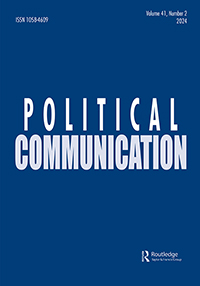Fake News for All: How Citizens Discern Disinformation in Autocracies
IF 5.1
1区 社会学
Q1 COMMUNICATION
引用次数: 0
Abstract
ABSTRACTResearch on autocracies often posits that propaganda can manipulate citizens’ beliefs, but existing work does not systematically investigate how well individuals recognize misinformation in authoritarian environments and whether susceptibility to propaganda is related to vulnerability to false news. I present the results of four surveys in Russia, in which more than 60,000 participants evaluated 74 true and false news headlines. I find that Russians’ capacity to discern falsehoods is comparable to discernment found in other political contexts, and they could often detect false news stories. However, consumers of state media gave less accurate evaluations than consumers of independent media, and government supporters were substantially more susceptible to pro-regime misinformation than opposition-minded citizens. Supporters also strongly rejected true messages inconsistent with their political dispositions. These results help understand why in environments dominated by propaganda individuals can be quite vulnerable to information manipulation. At the same time, regime critics in my study often fell for propaganda-inconsistent falsehoods. These results highlight the broader challenge of fighting misinformation and propaganda in a situation when many citizens exhibit political biases.KEYWORDS: MisinformationpropagandaautocracyRussia AcknowledgementI am grateful to Scott Gehlbach, Yoshiko Herrera, Rikhil Bhavnani, Jessica Weeks, Adeline Lo, Quintin Beazer, Holger Kern, Bryn Rosenfeld, Andrew Little, Jon Green, Noah Buckley, Georgiy Syunyaev, Mingcong Pan, to the participants at the ASEEES annual meeting (2020) and various colloquia and conferences at the University of Wisconsin–Madison, as well as two anonymous reviewers for their helpful comments and suggestions.Disclosure StatementNo potential conflict of interest was reported by the author(s).Data Availability StatementThe data that support the findings of this study are available from the corresponding author, A.S., upon reasonable request.Supplementary MaterialSupplemental data for this article can be accessed on the publisher’s website at https://doi.org/10.1080/10584609.2023.2257618Notes1. I use the terms “state media’’ and “propaganda outlets’’ interchangeably.2. https://www.facebook.com/help/1881188083573793. This study uses a dichotomized (true/false) measure of perceived news veracity because its premise, discussed below, implied that there would be true and false messages, and the stories were selected in such a way that their central claim was clearly true or false. This measurement approach was employed in several recent studies of vulnerability to misinformation (see e.g., Bago et al., Citation2020; Pennycook et al., Citation2021), and it makes comparisons with other work straightforward. Moreover, as Pennycook and Rand (Citation2019a) show, dichotomized measures produce results similar to more fine-grained scales.4. See, e.g., a recurring BuzzFeed quiz on fake news: https://www.buzzfeed.com/tag/fake-news-quiz.5. In addition, I have conducted a robustness check of the baseline results, dropping stories that may have been seen as potentially more ambiguous (see Table A12 for details); the results are similar.6. For details on the selection procedure, see the appendix.7. There was no monetary compensation for participation in Studies 1 and 2; as noted above, the respondents completed the surveys to find out how well they would recognize falsehoods.8. https://mediascope.net/news/1250827/.9. https://ppc.world/articles/auditoriya-shesti-krupneyshih-socsetey-v-rossii-v-2020-godu-izuchaem-insayty/.10. The unusually high belief in false stories in quiz 1 in Study 1 may follow from a less balanced story selection: that quiz included only five false stories, two of which many respondents viewed as plausible.11. The estimates are very similar when adjusting for covariates, omitting demographic weights, and controlling for randomly assigned news sources. See Table A21.12. Discernment rates are calculated as contrasts from the same regression model.13. As Table A4 in the appendix shows, Putin supporters were less likely to believe all critical messages, both true and false, whereas Putin critics were less likely to believe all pro-regime messages.Additional informationFundingI acknowledge financial support from the Harriman Institute (Columbia University), the Department of Political Science, the Center for Russia, East Europe, and Central Asia, and the Office of the Provost (all at UW–Madison). This work was also assisted by a dissertation writing grant from the Association for Slavic, East European, and Eurasian Studies.Notes on contributorsAnton ShirikovAnton Shirikov (PhD, University of Wisconsin–Madison, 2022) is a Postdoctoral Scholar in Russian Politics at the Harriman Institute, Columbia University. His research focuses on propaganda, disinformation, and media in Russia and other authoritarian regimes, as well as the politics of post-communism.《全民假新闻:专制国家的公民如何辨别虚假信息
他的研究主要集中在俄罗斯和其他专制政权的宣传、虚假信息和媒体,以及后共产主义的政治。
本文章由计算机程序翻译,如有差异,请以英文原文为准。
求助全文
约1分钟内获得全文
求助全文
来源期刊

Political Communication
Multiple-
CiteScore
13.90
自引率
2.70%
发文量
30
期刊介绍:
Political Communication is a quarterly international journal showcasing state-of-the-art, theory-driven empirical research at the nexus of politics and communication. Its broad scope addresses swiftly evolving dynamics and urgent policy considerations globally. The journal embraces diverse research methodologies and analytical perspectives aimed at advancing comprehension of political communication practices, processes, content, effects, and policy implications. Regular symposium issues delve deeply into key thematic areas.
 求助内容:
求助内容: 应助结果提醒方式:
应助结果提醒方式:


